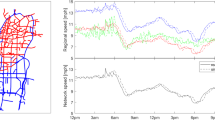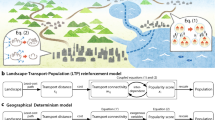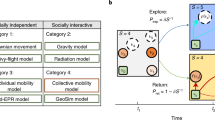Abstract
Many human social phenomena, such as cooperation1,2,3, the growth of settlements4, traffic dynamics5,6,7 and pedestrian movement7,8,9,10, appear to be accessible to mathematical descriptions that invoke self-organization11,12. Here we develop a model of pedestrian motion to explore the evolution of trails in urban green spaces such as parks. Our aim is to address such questions as what the topological structures of these trail systems are13, and whether optimal path systems can be predicted for urban planning. We use an ‘active walker’ model14,15,16,17,18,19 that takes into account pedestrian motion and orientation and the concomitant feedbacks with the surrounding environment. Such models have previously been applied to the study of complex structure formation in physical14,15,16, chemical17 and biological18,19 systems. We find that our model is able to reproduce many of the observed large-scale spatial features of trail systems.
This is a preview of subscription content, access via your institution
Access options
Subscribe to this journal
Receive 51 print issues and online access
$199.00 per year
only $3.90 per issue
Buy this article
- Purchase on Springer Link
- Instant access to full article PDF
Prices may be subject to local taxes which are calculated during checkout




Similar content being viewed by others
References
Axelrod, R. & Dion, D. The further evolution of cooperation. Science 242, 1385–1390 (1988).
Clearwater, S. H., Huberman, B. A. & Hogg, T. Cooperative solution of constraint satisfaction problems. Science 254, 1181–1183 (1991).
Helbing, D. Quantitative Sociodynamics Stochastic Methods and Models of Social Interaction Processes(Kluwer Academic, Dordrecht, (1995)).
Makse, H. A., Havlin, S. & Stanley, H. E. Modelling urban growth patterns. Nature 377, 608–612 (1995).
Herman, R., Lam, T. & Prigogine, I. Multilane vehicular traffic and adaptive human behavior. Science 179, 918–920 (1973).
Herman, R. & Prigogine, I. Atwo-fluid approach to town traffic. Science 204, 148–151 (1979).
Helbing, D. Verkehrsdynamik. Neue physikalische Modellierungskonzepte(Springer, Berlin, (1997)).
Henderson, L. F. The statistics of crowd fluids. Nature 229, 381–383 (1971).
Henderson, L. F. Sexual differences in human crowd motion. Nature 240, 353–355 (1972).
Helbing, D. & Molnár, P. Social force model for pedestrian dynamics. Phys. Rev. E 51, 4282–4286 (1995).
Haken, H. Advanced Synergetics 2nd edn(Springer, Berlin, (1987)).
Nicolis, G. & Prigogine, I. Self-Organization in Nonequilibrium Systems. From Dissipative Structures to Order through Fluctuations(Wiley, New York, (1977)).
Schenk, M. Untersuchungen zum Fußgängerverhalten Thesis, Univ. Stuttgart((1995)).
Kayser, D. R., Aberle, L. K., Pochy, R. D. & Lam, L. Active walker models: tracks and landscapes. Physica A 191, 17–24 (1992).
Lam, L. Active walker models for complex systems. Chaos Solitons Fractals 6, 267–285 (1995).
Schweitzer, F. & Schimansky-GGeier, L. Clustering of “active” walkers in a two-component system. Physica A 206, 359–379 (1994).
Schimansky-Geier, L., Mieth, M., Rosé, H. & Malchow, H. Structure formation by active Brownian particles. Phys. Lett. A 207, 140–146 (1995).
Ben-Jacob, E. et al. Generic modelling of cooperative growth patterns in bacterial colonies. Nature 368, 46–49 (1994).
Stevens, A. & Schweitzer, F. in Mechanisms of Cell and Tissue Motion(eds Alt, W., Deutsch, A. & Dunn, G.) 183–192 (Birkhäuser, Basel, (1997)).
Eigen, M. & Schuster, P.The Hypercycle(Springer, Berlin, (1979)).
Feistel, R. & Ebeling, W. Evolution of Complex Systems. Self-Organization, Entropy and Development(Kluwer, Dordrecht, (1989)).
Timmermans, H., van der Hagen, X. & Borgers, A. Transportation systems, retail environments and pedestrian trip chaining behaviour: Modelling issues and applications. Transportation Res. B 26, 45–59 (1992).
Hillier, B. Space is a Machine: A Configurational Theory of Architecture(Cambridge Univ. Press, (1996)).
Acknowledgements
We thank F. Schweitzer for discussions, and W. Weidlich and M. Treiber for reviews of the manuscript.
Author information
Authors and Affiliations
Corresponding author
Rights and permissions
About this article
Cite this article
Helbing, D., Keltsch, J. & Molnár, P. Modelling the evolution of human trail systems. Nature 388, 47–50 (1997). https://doi.org/10.1038/40353
Received:
Accepted:
Issue Date:
DOI: https://doi.org/10.1038/40353
This article is cited by
-
Cognitive-Cultural Looping Mechanism of Urban Space Conceptualization
Integrative Psychological and Behavioral Science (2023)
-
Paved guideway topology optimization for pedestrian traffic under Nash equilibrium
Structural and Multidisciplinary Optimization (2021)
-
An Agent-Based Model for Simulating Electrified Social Insects Traffic Behavior
Brazilian Journal of Physics (2021)
-
Large-Scale Dynamics of Self-propelled Particles Moving Through Obstacles: Model Derivation and Pattern Formation
Bulletin of Mathematical Biology (2020)
-
Automatic quality evaluation of parade by variance of postures of a platoon on single video camera logs
Artificial Life and Robotics (2020)
Comments
By submitting a comment you agree to abide by our Terms and Community Guidelines. If you find something abusive or that does not comply with our terms or guidelines please flag it as inappropriate.



